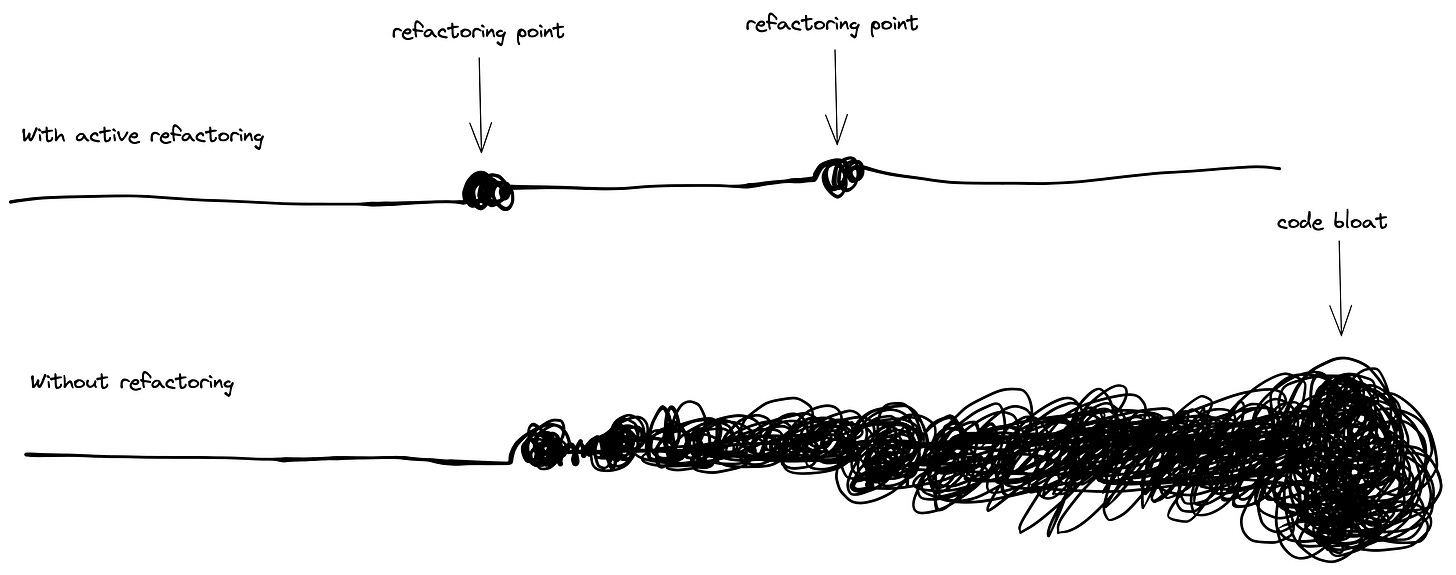Why is Refactoring Important?
Continuous Refactoring
Refactoring is a crucial practice in software engineering, akin to an art form. It involves reorganizing existing code and its structures to enhance code quality, readability, and maintainability. During refactoring, superfluous code is typically eliminated to keep the codebase concise and comprehensible. This process aims to simplify and organize complexities within the code.
In the realm of software development, projects often begin with a straightforward approach, but as new features are introduced, code complexity tends to grow. The original design may become inadequate to accommodate these new requirements. When engineers encounter this situation, they face two options:
Refactoring: This involves revisiting the existing codebase and improving its design to align with the new requirements. It's about proactively managing and reducing complexity as it arises.
Extending the Existing Design: Alternatively, engineers can choose to patch the existing design to accommodate new features, even if it doesn't fit seamlessly with the original structure. This approach can lead to growing chaos and complexity over time.
Consider the diagram below: In the case of active refactoring, engineers address complexity as it emerges, ensuring that it remains under control. However, without regular refactoring, complexity accumulates until it becomes unmanageable, resulting in a bloated codebase that no one can decipher or extend. At this stage, overhauling the entire project becomes necessary, as opposed to the more incremental and sustainable practice of refactoring.
Refactoring should be a continuous practice and not something left until the code has become excessively bloated. It's essential to identify refactoring points throughout the development process. While pinpointing these points often relies on experience and judgment, some common indicators can help guide your decisions:
Difficulty Adding New Features: If you encounter challenges when trying to integrate new features into the codebase because the existing structure doesn't easily accommodate them, it's a clear sign that refactoring may be necessary. Refactoring can make the code more flexible and adaptable.
Code Maintenance Challenges: When it becomes challenging to read and understand the code or fix issues that arise during live operations, it's a strong indicator that the code may need refactoring. Complex, convoluted code is prone to errors and difficult to maintain.
Lack of Clarity: If team members frequently seek clarification on the logic and struggle to extend the codebase, it suggests that the code's design and organization may be unclear or inadequate. Refactoring can improve code clarity, making it easier for others to work with.
In essence, a refactoring point is a juncture where the code's current state impedes its maintainability, readability, or adaptability. Addressing these issues as they arise, rather than waiting for code bloat, helps maintain a healthy and manageable codebase throughout the software development lifecycle. Regularly identifying and addressing refactoring points is a proactive approach that contributes to code quality and project sustainability.
Refactoring serves as an ongoing improvement process that ensures the code remains current, comprehensible, and maintainable. Continuous refactoring brings about several benefits:
Enhanced Developer Experience: Continuous refactoring improves the overall developer experience. New team members can easily onboard and start working with the codebase. This streamlines the process of understanding the code's structure and logic, leading to a happier and more productive developer team.
Improved Maintainability and Readability: Continuous refactoring ensures that the code consistently mirrors the actual behavior required by the business. It achieves this by presenting the code in an organized and straightforward manner. This level of clarity makes it effortless for developers to read and understand the code, reducing the likelihood of errors and simplifying maintenance tasks.
Enhanced Engineering Efficiency: When code is regularly refactored, developers don't need to invest excessive time and effort deciphering its behavior when working on new features or addressing issues. This heightened efficiency allows for faster development cycles and quicker responses to business needs.
In summary, continuous refactoring is a pivotal practice in software development that fosters a positive developer environment, bolsters code maintainability and readability, and ultimately leads to increased engineering efficiency. It ensures that the codebase remains a valuable and adaptable asset for the organization as it evolves to meet changing business requirements.


